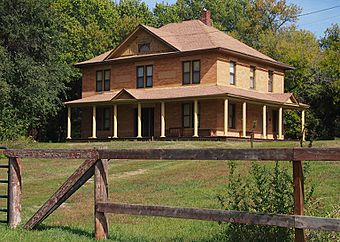Larson's Hunters Resort facts for kids
Larson's Hunters Resort was once a popular place for hunters to stay in Lake Valley Township, Minnesota. It was open from the 1890s until the 1960s. This resort was very well-known in Traverse County, Minnesota. It was also a working farm at the same time.
Larson's Hunters Resort was added to the National Register of Historic Places in 1985. This means it is an important historical site. It shows how people lived and worked in the past. The resort includes a large brick farmhouse built in 1901. It also has eight other buildings. This place is special because it shows the history of hunting in Minnesota. It also shows how farmers sometimes ran resorts. The main house is also one of the biggest and most complete brick farmhouses in Traverse County.
What Larson's Hunters Resort Looks Like
Larson's Hunters Resort covers about 4 acres of land. It is located on the east side of Mud Lake. The main building is a large farmhouse. It has two and a half stories and is made of smooth, light-brown bricks. The foundation is made of big rocks.
The roof is shaped like a hip roof. It has a part that sticks out on the west side. A long porch wraps around the west and south sides of the house. This porch has columns that hold up its own roof. The windows have smooth limestone sills and tops. There are also some simple designs made from bricks. Inside the house, there are 14 rooms with oak wood.
When the resort was added to the National Register, eight other buildings were still there. Five of these were cabins for hunters to rent. The other three were farm buildings. Three cabins were north of the farmhouse, among some trees. The biggest cabin was built in the early 1900s. It was later moved closer to the lake. Another cabin was built around 1940.
Southeast of the farmhouse was the Larsons' first house from 1891. After the bigger house was built in 1901, the old house became a granary. Later, it was moved again and used as a wash house, then a wood shed. In the 1930s, it became a guest cabin. Nearby was a garage for two cars, built around 1920. Part of this garage was an ice house at first. It became a cabin around 1941.
On the west side of the property, there was a granary built around 1928. It was one and a half stories tall and had wood siding. A hog barn from the early 1900s was moved south of the garage. It was used as a chicken coop and then a boathouse. Next to it was a small shed. Some other buildings, like a barn and a machine shed, were built in the 1890s but are no longer there.
The Story of Larson's Hunters Resort
Andrew Larson (1853–1921) and his wife Bertha (1859–1941) came from Sweden. They bought this land in 1890. They settled near other family members who had moved to Traverse County before them. At first, the Larsons lived in a dugout home. Then, they built a wood-frame farmhouse the next year. They started a farm with grain, cattle, and hogs. By 1904, they owned three more pieces of land.
Western Minnesota had many prairies, wet areas, rivers, and lakes. This meant there were lots of waterfowl (like ducks) and upland game birds (like pheasants). The Red River of the North was also a major path for migrating birds. Train lines were built in the 1870s. This made the area a popular place for hunting trips.
Thousands of hunters came from cities like Minneapolis–Saint Paul. They often traveled in special train cars just for hunters. Hotels in western Minnesota towns welcomed these visitors. They even put extra beds in hallways when all rooms were full. Local farmers soon saw a chance to make extra money. Many farm families would pick up guests at the train station. They would bring them back to their farms by wagon. There, hunters got beds, breakfast, dinner, and packed lunches. Some farmers even worked as guides. Most of this was informal. But a few families turned it into a real business.
Andrew and Bertha Larson were among these families. They started hosting hunters in the late 1890s. In 1901, they decided to make it a bigger business. They hired Alfred Setterlund, an architect from nearby Wheaton, Minnesota. Setterlund designed a larger farmhouse that would also be a lodge. It had eight guest rooms, a big kitchen, a dining room, and a library. The bricks for the walls came from St. Louis. They were shipped by train to Herman, Minnesota, then carried to the farm by wagons.
Soon, with more cabins and even space for hunters to set up their own tents, Larson's Hunters Resort could host 50 or 60 guests at a time. They also offered special flat-bottom boats for use on the shallow lake.
Traverse County was one of the best hunting spots in western Minnesota. Larson's Hunters Resort was one of its most famous resorts. Some hunters stayed for weeks. They would hunt many thousands of birds. Minnesota started making game laws and hunting limits in the late 1800s. But it took a while for these rules to be fully followed.
Andrew Larson passed away in 1921. His son Edward and his wife Mabel took over the resort. Over time, too much hunting caused the bird populations to drop a lot in the 1950s and 60s. Edward and Mabel Larson closed the resort business in the 1960s. The property stayed in the family until 1979.




